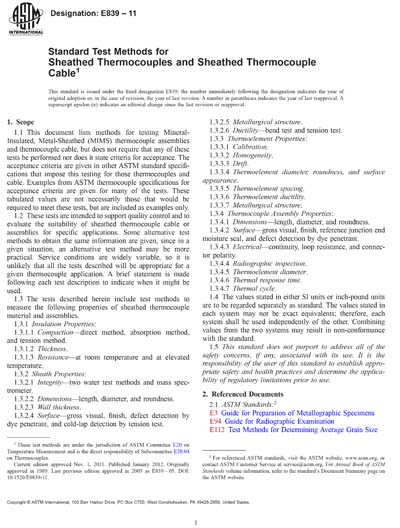Historical
ASTM E839-11
Standard Test Methods for Sheathed Thermocouples and Sheathed Thermocouple Cable
1.1 This document lists methods for testing Mineral-Insulated, Metal-Sheathed (MIMS) thermocouple assemblies and thermocouple cable, but does not require that any of these tests be performed nor does it state criteria for acceptance. The acceptance criteria are given in other ASTM standard specifications that impose this testing for those thermocouples and cable. Examples from ASTM thermocouple specifications for acceptance criteria are given for many of the tests. These tabulated values are not necessarily those that would be required to meet these tests, but are included as examples only.
1.2 These tests are intended to support quality control and to evaluate the suitability of sheathed thermocouple cable or assemblies for specific applications. Some alternative test methods to obtain the same information are given, since in a given situation, an alternative test method may be more practical. Service conditions are widely variable, so it is unlikely that all the tests described will be appropriate for a given thermocouple application. A brief statement is made following each test description to indicate when it might be used.
1.3 The tests described herein include test methods to measure the following properties of sheathed thermocouple material and assemblies.
1.3.1 Insulation Properties:
1.3.1.1 Compaction—direct method, absorption method, and tension method.
1.3.1.2 Thickness.
1.3.1.3 Resistance—at room temperature and at elevated temperature.
1.3.2 Sheath Properties:
1.3.2.1 Integrity—two water test methods and mass spectrometer.
1.3.2.2 Dimensions—length, diameter, and roundness.
1.3.2.3 Wall thickness.
1.3.2.4 Surface—gross visual, finish, defect detection by dye penetrant, and cold-lap detection by tension test.
1.3.2.5 Metallurgical structure.
1.3.2.6 Ductility—bend test and tension test.
1.3.3 Thermoelement Properties:
1.3.3.1 Calibration.
1.3.3.2 Homogeneity.
1.3.3.3 Drift.
1.3.3.4 Thermoelement diameter, roundness, and surface appearance.
1.3.3.5 Thermoelement spacing.
1.3.3.6 Thermoelement ductility.
1.3.3.7 Metallurgical structure.
1.3.4 Thermocouple Assembly Properties:
1.3.4.1 Dimensions—length, diameter, and roundness.
1.3.4.2 Surface—gross visual, finish, reference junction end moisture seal, and defect detection by dye penetrant.
1.3.4.3 Electrical—continuity, loop resistance, and connector polarity.
1.3.4.4 Radiographic inspection.
1.3.4.5 Thermoelement diameter.
1.3.4.6 Thermal response time.
1.3.4.7 Thermal cycle.
1.4 The values stated in either SI units or inch-pound units are to be regarded separately as standard. The values stated in each system may not be exact equivalents; therefore, each system shall be used independently of the other. Combining values from the two systems may result in non-conformance with the standard.
1.5 This standard does not purport to address all of the safety concerns, if any, associated with its use. It is the responsibility of the user of this standard to establish appropriate safety and health practices and determine the applicability of regulatory limitations prior to use.
Content Provider
ASTM International [astm]






